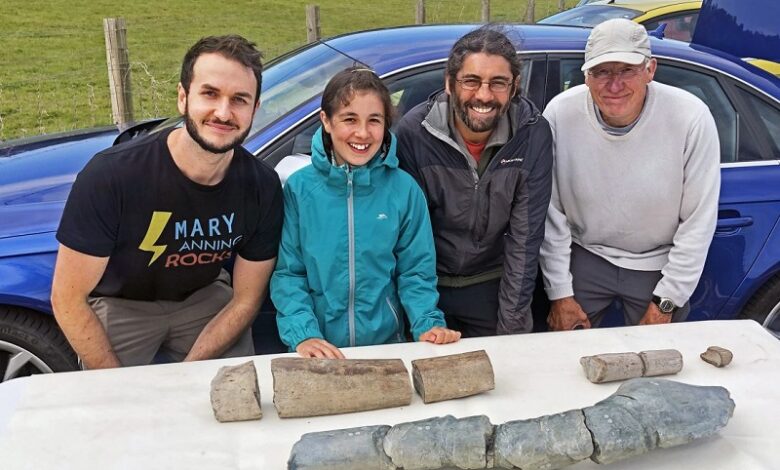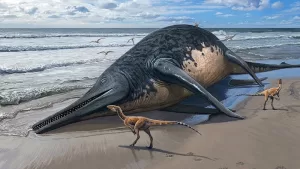Scientists Unveil Discovery of Gigantic Marine Reptile Fossil Larger than Two Buses

News Mania Desk / Agnibeena Ghosh/18th April 2024
In a groundbreaking revelation, scientists have unveiled what is believed to be the largest marine reptile ever to have roamed the seas, a colossal creature surpassing the length of two buses, which thrived alongside dinosaurs some 202 million years ago.
Discovered in 2016 by a fossil enthusiast combing the shores of Somerset, UK, the creature’s fossilized jawbone provided the first tantalizing glimpse of its immense proportions. In 2020, another similar jawbone was fortuitously found by a father-daughter duo, further bolstering the scientific understanding of this prehistoric leviathan.
Upon careful analysis, experts have concluded that these fossils likely belonged to two giant ichthyosaurs, marine reptiles estimated to have reached lengths of up to 25 meters. This size dwarfs even the formidable pliosaur, immortalized in David Attenborough’s documentary “The Giant Sea Monster,” whose remains were discovered embedded in Dorset cliffs.

Dr. Dean Lomax, a palaeontologist at the University of Bristol, who co-authored the scientific paper published on Wednesday, explains that while the jawbones provide crucial insights into the creature’s dimensions, a complete skull and skeleton are necessary for precise measurements. Nonetheless, based on existing evidence, the creature’s size is believed to rival that of a blue whale.
The newfound species, dubbed Ichthyotitansevernensis, or the giant fish lizard of the Severn, represents a significant addition to the pantheon of prehistoric marine life. Dean Lomax, along with Ruby Reynolds, co-author of the latest scientific paper, underscores the invaluable contributions of amateur fossil collectors like Paul de la Salle and Justin and Ruby Reynolds, whose keen observations and dedication have unearthed remarkable discoveries.
Paul de la Salle’s serendipitous encounter with the first jawbone set the stage for subsequent findings, while Justin and Ruby Reynolds’ discovery provided critical corroborating evidence. Their collaborative efforts, spanning years of meticulous analysis and excavation, culminated in the identification of this colossal marine reptile.
The significance of such discoveries extends beyond the realm of academia, as they underscore the vital role of amateur enthusiasts in advancing scientific knowledge. Dean Lomax emphasizes that anyone armed with patience and a discerning eye can contribute to groundbreaking discoveries, emphasizing the democratization of paleontological research.
As the fossils prepare to go on public display at the Bristol Museum and Art Gallery, they serve as a testament to the enduring allure of paleontology and the profound mysteries awaiting discovery beneath the Earth’s surface.






